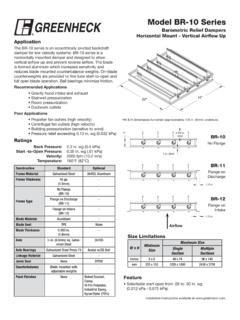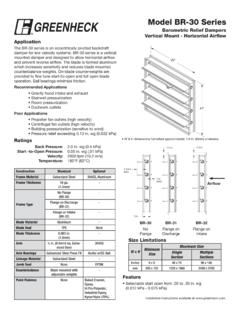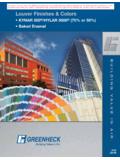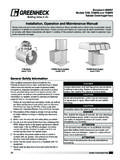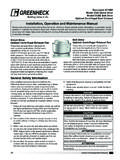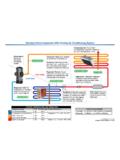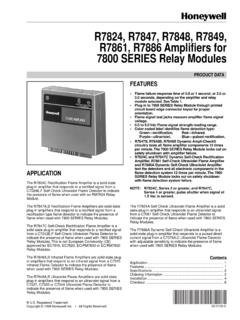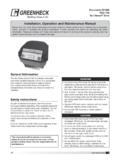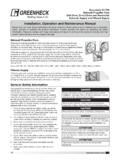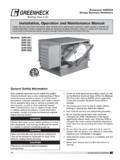Transcription of Fan Fundamentals - Greenheck Fan
1 Fan Fundamentals Introduction to FAN SELECTION. This is a guide to the most basic fan sections, all of which enable you to select the right fan for the job. It will answer the following questions (and more): What is a SONE? How are model numbers and performance tables used to select a fan? How are direct drive and belt driven fans different? What types of motors are used with these fans? The goal is to understand and use the Greenheck literature as an important tool in filling a customer's fan order. Terms cfm Cubic Feet Per Minute. A measure of airflow. Ps Static Pressure.
2 Resistance to airflow measured in inches of water gauge. A measure of loudness. One sone can be approximated as the loudness of a quiet refrigerator at a distance of 5 feet. Sones sone follow a linear scale, that is, 10 sones are twice as loud as 5 sones. Bhp Brake Horsepower. A measure of power consumption. Used to determine the proper motor horsepower and wiring. hp Horsepower. Used to indicate a fan's motor size. rpm Revolutions Per Minute. Measure of fan speed. TS Tip Speed. The speed of the tip of a fan wheel or prop measured in feet per minute. Air Movement & Control Association.
3 A nationally recognized association which establishes standards for fan testing and AMCA. performance ratings. AMCA also license air volume and sound certified ratings. Model Designation For Greenheck belt drive models, the model designation BELT DRIVE DIRECT DRIVE. tells the model type, size and the motor hp. Suffix Motor hp Suffix Fan rpm 1/6. EXAMPLE: GB-090-6 6 A 1725. 4 1/4 B 1140 This table 3 1/3. C 860 lists model Model is GB hp is 1/6 designation Nominal Wheel Dia. 9 in. 5 1/2 D 1550 suffixes for motor 7 3/4 G 1300 horsepower and 10 1 E 1050. For direct drive units, the model designation tells 15 11/2 F 880.
4 Fan rpm. the model type, the size and the motor/fan rpm. 20 2 P 1625. EXAMPLE: G-121-B 30 3. 50 5. Model is G rpm is 1140 75 71/2. Nominal Wheel Dia. 12 in. Motor Information (Belt Drive Only) Speeds Motors are available in either single-speed or two speed. When specifying a belt drive fan, the model designation Single-speed motors are 1725 rpm. Two speed motors does not completely describe the unit. Additional will be 1725/1140 rpm. Single-speed will be supplied information about the motor is necessary. These items unless otherwise specified. are listed below: Electrical Characteristics Motor Enclosure Voltage and phase.
5 Voltage can be 115, 208, 230 or 460. This will be either Open (open, drip proof), TE (totally Phase is either single-or 3 phase. A 115 volt, single- enclosed) or EXP (explosion-resistant). Open is the phase motor is shown as 115/1. Typically, motors of most common and will be supplied unless otherwise 1/2 hp and less are single-phase. Motors of 3/4 hp and specified. greater are 3 phase. DIRECt Drive Selection of direct drive fans (those with the motor shaft Typical Motor Tag - Electrical Instructions connected to the fan wheel or propeller) is nearly the Suffix Letter Motor Speed Wiring Connections same as belt drive selection.
6 However, there are two differences worth noting. Where belt drive fan speed can D 1550 rpm White to L1 Black to L2. be altered by adjusting the motor pulley, direct drive fans G 1300 rpm White to L1 Blue to L2. (since they have no pulleys) must use a different method. E 1050 rpm White to L1 Red to L2. To adjust a direct drive fan's speed (also motor The three speeds are 1550 rpm (D), 1300 rpm (G) and 1050. 1. speed) or to provide a means of meeting an exact rpm (E). Changing a motor lead is all that is necessary to performance requirement, a speed control can be change speeds.
7 When selecting a model with a 3 speed furnished. Speed controls vary the voltage supplied to motor, it is recommended that the G speed be chosen the fan and slow whenever possible. This is the middle speed, which gives it down; a principle similar to the way dimmer light the greatest flexibility in air volume because airflow can be switches work. increased or decreased simply by changing a motor lead. 2 Models CUE and CW, sizes 060-095 and Model SQ, sizes 60-95, are provided with 115 volt, 60 cycle motors. FAN Fundamentals 129. Introduction to FAN SELECTION. Motor Horsepower The motor horsepower for direct drive fans is If this is the case, we will need a 1/2 hp motor always sized by Greenheck and does not require because our fan will have to run at almost further consideration.
8 For belt drive models, 810 rpm (refer to performance box - 2052 cfm at the catalog identifies which horsepower is in. Ps). Therefore, choosing a 1/2 hp motor recommended. However, there are times when it in this case is exercising good judgement. is wise to bump the horsepower one size. For example, the hp recommended for the GB-180 The complete model designation for this at 810 rpm (2375 cfm @ .5 Ps) is 1/3 hp. application is GB-180-5. Note: The GB-180-5 has an rpm range of 700-940. Although a 1/3 hp motor is recommended, it is This means that if the static pressure is less than not necessarily a good motor selection for this estimated, say in.
9 Ps, the fan can be slowed down application. Our static pressure of in. was only to accommodate this condition. an estimate. It may actually turn out to be .625 in. Belt Drive One advantage of choosing a belt drive over a direct drive is that it is capable of adjusting the fan rpm, which enables the fan to move more air if necessary. Motor pulleys are adjusted by loosening the set Belt screw and turning the top half of the pulley (see illustrations at right). This causes the pulley diameter Opening the pulley decreases fan rpm. to change, which results in changing the fan rpm.
10 Closing the pulley increases fan rpm. Applications The information that follows will help walk you through this type of problem and enable you to Ventilating a building simply replaces stale or foul select the right fan for the job. air with clean, fresh air. Although the ventilation process is required for many different applications, the airflow Fundamentals never change: Fan Model Undesired air out, fresh air in Fans all perform the basic function of moving air The key variables that do change depending on from one space to another. But the great diversity of applications are the fan model and the air volume fan applications creates the need for manufacturers flow rate (cfm).
